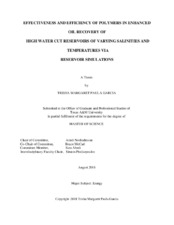| dc.description.abstract | The world‟s energy demand is increasing and all indications are that oil will be the leading energy supply for the foreseeable future. However, a significant amount of the world‟s „easy to produce oil‟, has been produced. Additionally, some of the remaining oil is rendered immobile due to capillary forces (residual oil) and some oil will be bypassed and remains trapped (bypassed oil) even after a reservoir has undergone secondary recovery. This remaining oil can account for 45- 70% of the original oil in a hydrocarbon reservoir. Therefore, methods to both improve and enhance oil recovery are highly sought. Enhanced oil recovery methods serve to recover such oil through techniques such as: thermal recovery, gas injection, and chemical injection. The latter is the subject of this thesis. Chemical injection involves the use of a surfactant to reduce the surface tension between the oil and the oil bearing rock layer and/ or polymers to increase the viscosity of the injected fluid and thereby improving sweep efficiency and mobility of oil, thus increasing production. In general, the polymers are not effective in removing residual oil and has some associated problems. Conventional polymers have been reported to plug oil reservoirs, biodegrade (biopolymers), or become impuissant in reservoirs with high salinity or high temperatures. Therefore a better solution is needed. This project will evaluate the effectiveness and efficiency of a cassava starch- based polymer with the aim of increasing producibility of residual and bypassed oil, while eliminating negative effects of conventional polymers. Laboratory experiments and computationally efficient models will be employed to simulate the physical performance of the starch- based polymer in reservoir regimes of varying salinities and temperatures. Lastly, a sensitivity analysis will be undertaken to
compare the recovery factor, concentration and profitability of starch- based polymer to that of two conventional polymers (Xanthan Gum and Hydrolysed Polyacrylamide (HPAM)).
Through the above methods, it was observed, that when compared to conventional HPAM and Xanthan Gum polymers, the cassava starch- based polymer provides substantive viscosities at low concentration, is more effective in high salinity and high temperature regimes than Xanthan Gum and HPAM but is highly susceptible to biodegradation unless treated with additives. In addition, the oil production capability is comparable to HPAM and Xanthan gum. Residual oil production was inconclusive, pending core flooding experiments.. | en |


